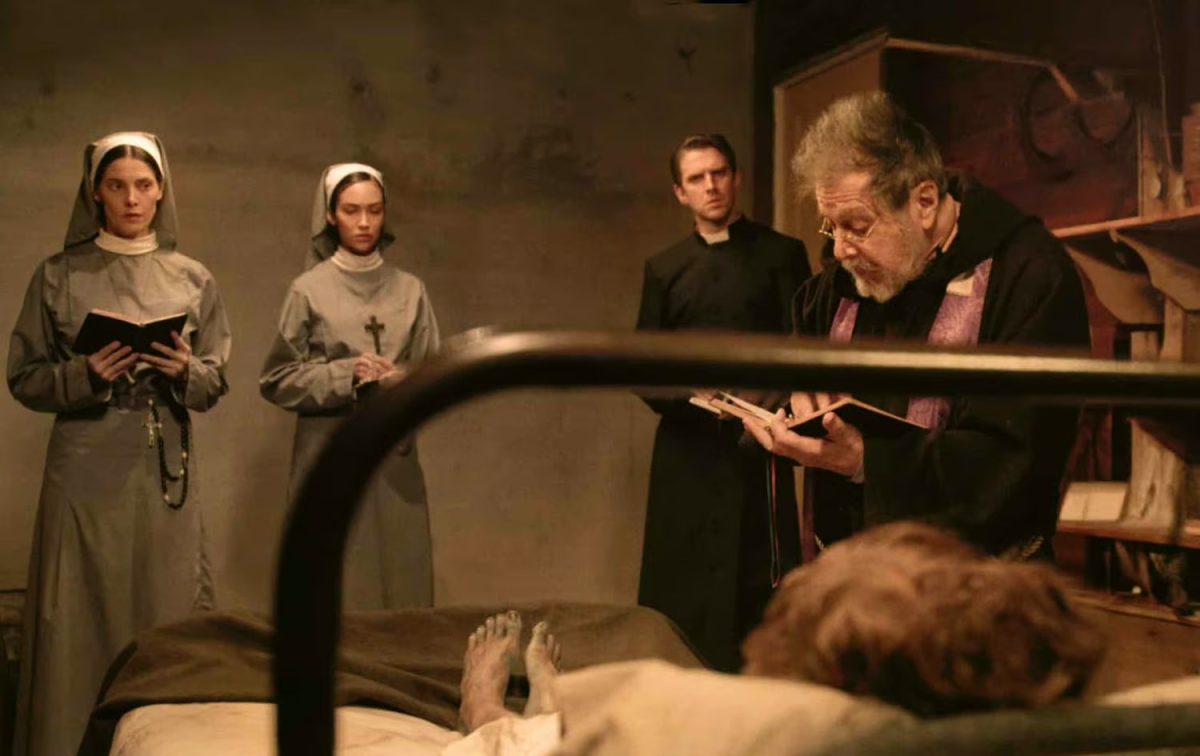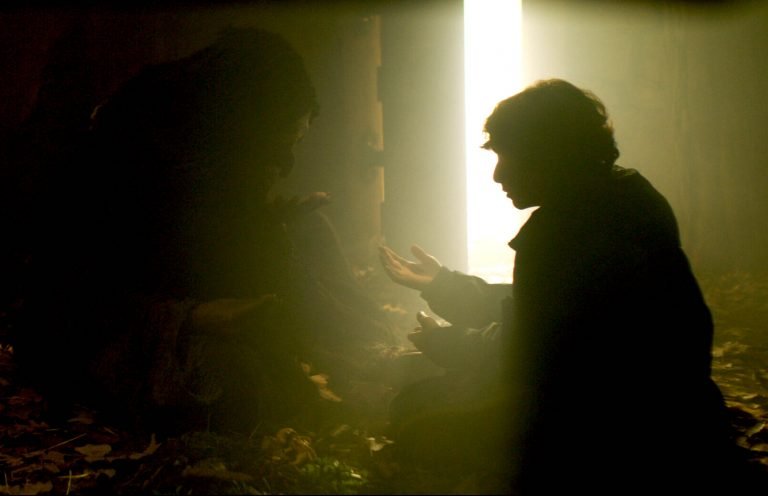David Midell’s “The Ritual” (2025) is a classic example of horror so ridiculously in-your-face it never elicits any surprise or jab. Rather, it’s painfully dull, telegraphing a naturalism that’s supposedly to be a display of immersion. None of the elements work because the writing and execution are victims of patent stupidity. There’s no inclination on the part of the makers to throw in shock, an edge of provocation. It aligns with the too-familiar terrain of exorcism horror. There’s the standard-issue afflicted, a priest determined to oust evil, and a hell lot of showy hysterics.
Things get tossed around, and commotion ensues. The possessed woman calls out individual demons and secrets. She knows what everyone around is hiding, including their pain and guilt. It’s the devil’s trick of drawing someone closer only to destroy them. This thorny dance of induction, seduction, and annihilation drives the haunted figure’s trick. That’s how the devil runs all in circles, teasing and manipulating.
The Ritual (2025) Plot Summary & Movie Synopsis:
You have to give it to the makers for being really sincere and unbending with piling on the mumbo-jumbo. They don’t waver at all. The film takes a frontal stance on the possessed and their flailing about. The drama is underlined, the overwhelming knot amplified, accentuated. But it cannot conceal the inherent shallowness of the material. The style is dull, uninspired, and the dialogues are mechanical and stagey. The film is deliberate in visually appearing like a relic of a past time, but it makes it look rather stodgy and feel thoroughly inert. A famous exorcism case from the 1920s, which has inspired several films and a subgenre itself, is recycled here.
The incident of Emma Schmidt’s demonic possession drives the narrative. But nothing here is fresh or offers a peculiar angle. There’s too much repetitiveness, derivativeness that clouds the entire film. A slew of rituals occurs, but it’s all so indistinct that everything just blurs together. The film ropes in Al Pacino and Dan Stevens but criminally asks little of them, except grand exertions and occasionally tortured gestures. Much of the heavy-lifting falls on Abigail Gowen, who has to go all out channelling extreme fits.
The film opens in the parish of Iowa. There’s the priest Joseph Stieger (Stevens), who has been experiencing tremors in his faith. The film establishes right away that the case you’ll be watching is the most notorious one recorded. Stieger has doubts about his practice. The recent death of his brother left him profoundly shaken. He struggles to believe what his practice exhorts him to. He carries out his duties at the parish and is sincere about it, but doesn’t deny that he has trouble subscribing to the divine solving everything. There must be equal, if not more, faith placed in the medical sciences.
That’s what he purports when Emma is brought to the parish. From the start, he insists her severe symptoms demand psychiatric or medical intervention. He states the parish cannot be of much help. It seems he has already surrendered before the crisis can hit the roof. Is he absolving himself of responsibility? Does he see how horribly things can go? He doesn’t have confidence. He balks at religious aid being of any substance in Emma’s situation. As he goes through her files, he’s furthermore convinced of his position. But in comes the imperious Roman Catholic senior priest, Theophilus (Al Pacino).

He surges in and pronounces he will take over the case. He requests Stieger to keep the faith. He’ll do whatever it takes to heal Emma, drive away the demons that have taken hold of her. Thus unravels a series of rituals he orchestrates. Now, don’t ask for specifics. The makers aren’t quite going for legibility here.
There’s a lot of chanting Pacino has to sell. He does pull off some of it with mighty conviction. This is an actor with a thundering presence. He doesn’t do even the amateurish stuff in half-measures. As the rituals seem to exacerbate Emma’s possession, unleash her bestiality and errant impulses, Theophilus rages even more to pin her down. He isolates her as she lashes out.
The possessed twentysomething girl derides the sisters at the parish. The demon incurs their repressed psyche, triggering them. How does she know what she professes? But the wicked can twist things around. Theophilus segregates her for this reason. Meanwhile, Stieger continues to rail on the need to take her immediately under medical care.
Finally, Theophilus lets Stieger in on a secret he had been hiding. He confesses he had come to Redding earlier and was deeply acquainted with Emma. He knew her as a young girl. Back then, he was just starting out and hadn’t gathered much experience in exorcism. He failed to read the room. The young Emma, who was already possessed, convinced him she was no longer so. He believed her. The demon was hiding, biding its time, and struck immediately after her mother died.
The Ritual (2025) Movie Ending Explained:
Does Emma’s exorcism succeed?
It’s believed that Emma had suspected an affair between her father, Jacob, and her mother’s sister, Mina. The two, in an effort to prevent her truth-telling, began feeding her all cursed food. That’s how the possession deepened and reached its terrifying present state. Theophilus regrets not catching the cue earlier and is full of guilt. There are a lot of personal remonstrations he inflicts on himself.
The film is structured around the various rituals, which don’t have much particular dimension or texture. They register variation in degrees of intensity and the volume of Theophilus’ chants. However, in the climactic ritual, it’s Stieger who takes charge and decides to do the chants himself. This seems to make all the difference.
The film’s climax is muddled because it doesn’t quite elaborate on what Stieger does differently that breaks the possession. It’s as if Stiegler had to confess his doubts about his father, affected by his brother’s untimely death, so that the rituals can swing through. It’s too vague and contrived and fails to explicate and establish the critical outcome of the narrative itself. A postscript informs that Emma didn’t suffer the possession any longer.








